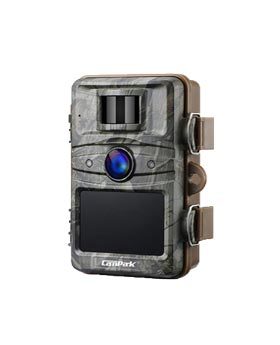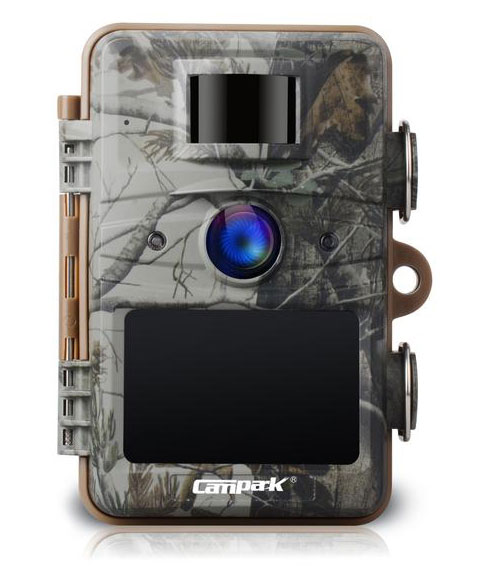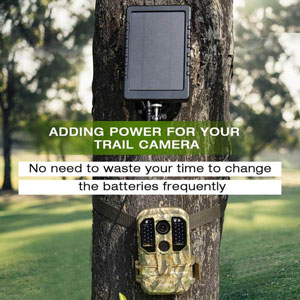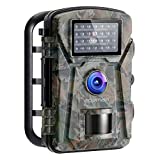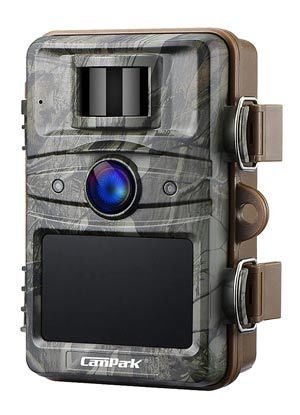 It can be very hard to find a trail camera that is value-priced and comes with a no glow flash. Too often no glow trail cameras are priced out of range of budget-conscious buyers and are difficult to consider purchasing for people who might be thinking of buying multiple trail cameras. Thankfully, the Campark T70 trail camera has helped address this problem.
It can be very hard to find a trail camera that is value-priced and comes with a no glow flash. Too often no glow trail cameras are priced out of range of budget-conscious buyers and are difficult to consider purchasing for people who might be thinking of buying multiple trail cameras. Thankfully, the Campark T70 trail camera has helped address this problem.
Table of Contents
Why Should You Want A No Glow Trail Camera?
If we were to give you a one-word answer to this question it would be VERSATILITY.
Having a trail camera with no glow flash means that it remains completely undetectable when capturing pictures or videos at night.
Since these cameras won’t disclose their location at night you can feel confident putting them in locations and use them for purposes that might not be appropriate for their low glow counterparts. You can use them for security cameras since trespassers or thieves won’t know where they are located even if they look directly at the no glow camera while it is in use. You can also feel more confident putting a no glow trail camera on public hunting land without fear of it being stolen by unscrupulous hunters.
Introducing the Campark T70 Trail Camera
The Campark T70 is an inexpensive bread-and-butter trail camera that covers all of your basic wildlife surveillance needs with the huge bonus of having a no glow flash. This camera is a sturdy and energy-efficient trail camera that is capable of staying active without any attention for a whole season. Plus, its high definition camera and quick shutter speed help it to capture every passing animal. With this solid feature set, the T70 is a reliable way of capturing high-quality images and videos over a long time frame and with minimal maintenance.
Pros
- No glow flash
- Affordable price point
- Reliable sensor and adjustable shutter speeds
- Tough and weatherproof
Cons
- Trigger speed could be a little faster
- The instruction manual could be a little better
See Current Sale Price and Learn More Here
In-Depth Review of Key Features
Camera
The T70 trail camera takes video in native 1080p, and its camera has a 16 megapixel camera.
It also has an adjustable shutter speed to help you fine-tune your pictures. This can be especially helpful for pictures at night.
Motion Sensor
The T70 can sense motion within a range of 65 feet. The sensor can detect motion at an angle of 50 degrees from its placement, so the camera should be placed such that the area to be surveilled is directly in front of it in order to capture most pictures and videos.
Trigger Speed
The Campark T70 has a 0.5 second trigger speed. It’s more than enough to catch images of deer or other game animals moving at normal speeds or to get a picture of a burglar, but won’t necessarily pick up every bird or squirrel. It’s close to average for trail cameras, especially for cameras in this price range. While it isn’t slow this is the one area where we wish the T70 was a little better, but given the price maybe we are being a little greedy.
Flash
The T70 has a No Glow IR flash delivered by 44 LED bulbs. This is important because it makes the camera more versatile. No glow flash allows you to use the trail camera on public land or other places where you might otherwise worry about the trail camera being stolen. Since the no glow flash doesn’t give away the camera’s location when taking pictures or videos at night it also allows you to use the camera on your property for security and surveillance purposes.
The camera has High and Low flash settings and can also be set to automatically adjust the brightness depending on power settings, but the lower settings can result in muddy pictures in some situations.
Here is a sample of videos that were captured by the T70 during the day and at night using the no glow flash:
LCD Screen
The T70 features a 2.4” color LCD screen, which makes the setup process easier and allows you to easily see what your camera is capturing while it is still in the field.
This screen comes with a resolution of 480 x 234. So to see the images at their full resolution, you’ll have to view them on your computer or another device.
Memory Card
The T70 can use SD cards up to 32GB in capacity. Campark recommends using Class 10 cards with the camera. We suggest using the SanDisk 32GB Ultra SDHC memory card.
While the type of memory card used isn’t a make or break feature if you have read our other reviews or buying guides you know that we prefer the standard-sized SD cards for their larger size. Having a larger memory card makes it easier to put in and out of the camera if you are outside in cold temperatures or if you simply have larger fingers. So the fact that the T70 uses a standard-sized SD card is a bonus in our book.
Batteries
The T70 takes 8 AA batteries, and Campark even recommends rechargeable NiMH (nickel-metal hybrid) batteries. That being said we still prefer high quality lithium batteries. If you want to learn more about the various battery options and which ones are best for trail cameras click here.
Input for External 6V Power Supply
It can also use an external 6-volt power supply with at least 2 amps of power. Neither the batteries nor the power supply is included. If you want to leave the camera active for a very long period of time, we recommend that you think about buying an external power supply. In the long run, it will probably save you money on batteries, even if you get rechargeable ones.
If you are interested in having a solar panel as your external power source you might appreciate knowing that Campark makes their own solar power bank that is compatible with the T70 as well as with many other trail camera models. A picture of this solar panel is shown above.
You can see the current price of Campark’s Trail Camera Solar Panel here.
Image Stamp
Like almost all trail cameras these days the Campark T70 has an image stamp. It shows the date, time, temperature, and moon phase on the videos and pictures the camera captures. You can choose to turn the image stamp on or off in the setup menu.
Price
Compared to other cameras with similar capabilities, of which there are few, the Campark T70 comes at a very reasonable price. If you buy a cheaper model, it might not meet your needs as well as the T70 will. If money is no object, though, you could spend more and get a camera with more features, or for a really serious price, a whole set of cameras that communicate wirelessly.
This model’s price is perfect if it’s your first trail camera, though, or if you’re supplementing a setup you already have.
Other Options
Campark T86 Trail Camera
If you like the T70 but are wondering what a camera with a few more advanced features would look like, the Campark T86 is worth your consideration. The T86 not only sports a camera that can take 20MP pictures and record video in 1296p resolution, both of which are a step-up from the T70, but it also had WiFi and Bluetooth connectivity. In addition, the T86 also comes with 3 PIR sensors. With all three sensors, the camera has a 120° detection angle, but the side sensors can also be turned off if you place the camera in an area where it is struggling with false triggers. All of these features more than justify the small price difference between the T86 and the T70.
We did a full review of the Campark T86 and its virtual twin, the Campark T85, and liked them both. You can click here if you want to read our review of the T86. Otherwise, you can see the current sale price of the T86 here.
APEMAN H45 Trail Camera
The APEMAN H45 has very comparable specs to the Campark T70. Plus, both cameras have the rare distinction of having no glow flash while being value-priced.
Among the short list of differences between these cameras are the number of no glow LED bulbs and trigger speed. The APEMAN H45 has 26 no glow LEDs whereas the Campark has 44. As far as trigger speed goes the APEMAN has a trigger speed of “less than 0.5 seconds” while the Campark has a listed trigger speed of 0.5 seconds, which gives a very small edge to the APEMAN in this area.
With both trail cameras being so similar you might struggle to decide which one you want to buy. So as you prepare to make your buying decision you might want to check the prices on both cameras to see if one happens to be on sale. You can see the current price of the APEMAN H45 here.
Final Thoughts
The Campark T70 trail camera doesn’t have all the bells and whistles, but it can do what matters and is a solid performer. It can stay active for a long time, this is especially true if you add an external power source, and can reliably capture images and footage of animals as they pass.
If it has one standout feature, it’s the no glow infrared flash, which is hard to find on such an affordably priced trail camera. The versatility of the T70 will allow you to use it in a variety of settings and for a variety of purposes. The only drawback is that if you plan to use it for security purposes it won’t alert you whenever it detects motion like a cellular trail camera could, but adding that functionality would raise the price significantly.
You can learn more about the Campark T70 and check the current price here.

